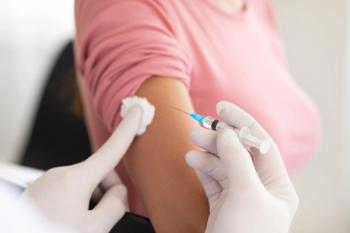
- Volume 0 0
Use of Risedronate for Prevention and Treatment of Osteoporosis
Osteoporosis is a common systemic skeletal disease characterized by low bone mineral density (BMD), microarchitectural deterioration, and predisposition to fractures.1 The World Health Organization has established definitions for osteoporosis based on bone density measurement at any skeletal site in white women (Table 1).
It is estimated that 10 million individuals in the United States, mostly over the age of 65, have osteoporosis, and another 18 million have low bone mass, which puts them at risk for this disease.2 Data from a recent survey of more than 200,000 postmenopausal women with no previous diagnosis of osteoporosis showed that 7.2% had osteoporosis and 39.6% had osteopenia.3 Almost one half of these women had previously undetected low bone mass. These results underscore the importance of identifying and managing this often clinically silent but rapidly progressive disease.
Fracture is the most devastating clinical consequence of osteoporosis, occurring in 1 of every 2 white women in their lifetime2 and in 30% to 50% of patients receiving longterm glucocorticoid therapy.4 Osteoporosis contributes to about 1.5 million fractures annually, of which 700,000 are vertebral fractures and 250,000 are hip fractures.2 These fractures, particularly hip fractures, are associated with considerable morbidity and mortality (Table 2) and a decreased quality of life.5 Therefore, prevention of fracture should be the primary goal of treatment in patients with osteoporosis.
Estrogen deficiency and glucocorticoid therapy are 2 major risk factors for osteoporosis.4,6 In postmenopausal osteoporosis, bone resorption exceeds bone formation, leading to bone loss and increased risk of fracture. Glucocorticoid- induced osteoporosis (GIO) occurs as a result of inhibited bone formation and increased bone resorption that yield net bone loss due to a variety of mechanisms.
Bisphosphonates decrease bone resorption without directly inhibiting bone formation.4,6 The bisphosphonates risedronate and alendronate are the most effective antiresorptive agents approved for the treatment of osteoporosis.7 These 2 drugs are approved for the prevention and treatment of postmenopausal osteoporosis in the United States.8,9 Risedronate is approved for both prevention and treatment of GIO in men and women, whereas alendronate is approved for treatment only.8,9 Alendronate also is approved for the treatment of osteoporosis in men.9
Pharmacologic Profile of Risedronate
Like all bisphosphonates, risedronate selectively adsorbs to active bone remodeling sites, where it acts to inhibit osteoclast-mediated bone resorption. Risedronate reduces the risk of fracture by preventing bone loss.10 This action results in increased BMD at fracture-prone skeletal sites, notably the lumbar spine and hip, in postmenopausal women with osteopenia11 or osteoporosis.12,13 It has the same effect in patients initiating14 or receiving15 high-dose, longterm ( 6 months) glucocorticoid therapy (prednisone 7.5 mg/d or equivalent).
Pharmacokinetic Properties
The pharmacokinetic characteristics of risedronate are summarized in Table 3.8,16-19 Risedronate is absorbed rapidly after oral administration and exhibits linear pharmacokinetics over the oral single-dose range of 5 mg to 30 mg.20 The extent of risedronate absorption is comparable when the dose is taken 30 minutes before breakfast or 2 hours after the evening meal, which may permit dosing flexibility.18 As with all bisphosphonates, the absorption of risedronate is reduced by food and by calcium-, aluminum-, and magnesium-containing compounds. For example, absorption may be reduced 55% if risedronate is taken less than 30 minutes prior to breakfast.8
Risedronate is not metabolized by, and it does not induce or inhibit, hepatic microsomal cytochrome P450 enzymes.8 Therefore, the potential for interaction between risedronate and drugs metabolized by this enzyme system is minimal. The elimination of risedronate is reduced in patients with impaired renal function.17 Therefore, because of a lack of clinical experience, the drug is not recommended for patients with severe renal impairment (creatinine clearance 30 mL/min).8
Clinical Efficacy of Risedronate
Osteoporosis is diagnosed on the basis of BMD T-scores. The efficacy of a study drug intended for use in osteoporosis is often assessed using BMD. This measure is not the only predictor of fracture risk, however, and it may not be the most clinically relevant measure of this risk.7 For example, in the Fracture Intervention Trial, improvement in spine BMD explained only 16% of the reduction in the risk of vertebral fractures that resulted from 3 years of treatment with alendronate.21 Similarly, spine BMD improvements with 2 years of risedronate treatment accounted for only 28% of the overall reduction in fractures.22
Changes in bone quality, particularly the integrity of the microarchitecture, account for the majority of the improvements in bone. Other predictors of fracture risk include age, previous and prevalent fragility fracture, premature menopause, and family history of fracture, as well as the use of glucocorticoids.21,23,24 Reduction in the risk of fracture may be the most important outcome in evaluating the effects of therapy in osteoporosis clinical trials.7,21,22,25
Results of well-designed, large-scale, prospective, randomized, doubleblind, placebo-controlled, long-term trials demonstrate that risedronate significantly reduces the risk of new osteoporosis-related vertebral,12,13 nonvertebral, 12,13 and hip26 fractures in postmenopausal women with osteoporosis, and vertebral fractures in men and women treated with glucocorticoids.
Postmenopausal Osteoporosis
The 2 pivotal risedronate clinical trials, are the Vertebral Efficacy with Risedronate Therapy-North American (VERT-NA) and Multinational (VERTMN) studies. An important outcome of these studies was the demonstration of a reduction in the risk of vertebral fractures after 1 year of therapy (by 65% in VERT-NA and by 61% in VERT-MN; P < .001 vs placebo for both outcomes).12,13 An analysis of pooled data from these 2 studies showed that risedronate 5 mg/d significantly reduced the risk of vertebral fractures as early as 6 months after treatment was initiated.27 The incidence of clinical vertebral fracture was 0.1% in the risedronate group versus 1% in the placebo group after 6 months of treatment (P < .01). Additionally, significant reductions in vertebral fracture risk were sustained with risedronate 5 mg/d for 3 years, the duration of the original study, and for 5 years in an extension of the 3-year trials.
The early onset of vertebral fracture risk reduction provided by risedronate is an important clinical benefit because postmenopausal women who experience a vertebral fracture have a 1 in 5 chance of experiencing another vertebral fracture within the following year. They also are at increased risk of a subsequent vertebral fracture or even a debilitating hip fracture.24
In addition, risedronate was found to reduce the risk of nonvertebral fracture. The risk of nonvertebral fracture was reduced by 40% (P = .02) and by 33% (P = .06) after 3 years of risedronate therapy in the VERT-NA and VERT-MN trials, respectively.12,13 In a 2- year extension of the VERT-MN trial, nonvertebral fracture risk reduction was maintained; it was 37% (P = .022) over the 5-year period.28 Because the incidence of nonvertebral fractures is typically low, data from 4 clinical trials N = 4845), ranging in length from 18 to 36 months and enrolling patients with confirmed osteoporosis, were pooled. After 1 year of treatment with daily risedronate, the risk of nonvertebral fractures was reduced by 56% P = .002) in postmenopausal women with osteoporosis.29
The Hip Intervention Program (HIP) trial was the only study to date specifically designed to prospectively evaluate the efficacy of antiresorptive treatment in reducing the risk of hip fracture.26 The study enrolled 2 specific groups of women: 1 group aged 70 to 79 years with confirmed osteoporosis (femoral neck BMD T-score <2.0) and the other aged at least 80 years with at least 1 clinical risk factor for fracture (eg, unsteady gait, age, propensity to fall). Risedronate therapy proved to be particularly beneficial for women with confirmed osteoporosis. In patients with severe osteoporosis (ie, with femoral neck BMD score <?2.5 and 1 vertebral fracture at baseline), the risk of hip fracture was reduced by 60% (P < .003).26 In women with osteoporosis at the femoral neck with no detectable fractures at baseline, the risk of hip fracture was reduced by 40% (P = .009). In the group of women selected only on the basis of risk factors for osteoporosis, however, the reduction in hip fracture risk was not significant.
The therapeutic equivalence of the risedronate 35-mg once-a-week and the 5-mg once-daily regimens in preventing postmenopausal bone loss was recently demonstrated.30 In a 12- month study of 1456 postmenopausal women over the age of 50 years with a lumbar spine T-score ?2.5 or ?2 with at least 1 prevalent vertebral fracture, lumbar spine BMD increases were similar in the 2 treatment groups (ie, 3.9% in the 35-mg once-a-week group vs 4% in the 5-mg once-daily group).30 Statistically significant increases in BMD above baseline at the femoral neck and trochanter in both the oncea- week and once-daily groups were similar between the 2 groups. Although the study was not designed to test for between-group differences in fracture risk, the incidence of new vertebral fractures was also similar in both groups at 12 months (1.3% and 1.5%, respectively).
To estimate the efficacy of risedronate 35 mg once a week in reducing the risk of new vertebral fractures at 1 year, placebo and risedronate 5-mgdaily groups were constructed by matching patients from the risedronate phase 3 vertebral fracture studies (VERTMN and VERT-NA) with patients in the once-a-week trial using the Brown et al study criteria.30 No statistically significant difference was observed in fracture incidence for the risedronate 5-mg/d groups from the phase 3 (1.7%) and once-a-week (1.5%) studies.31 Compared with matched placebo-treated patients, the risk of sustaining new vertebral fractures was reduced by 77% within 1 year in patients treated with risedronate 35 mg once a week. This reduction in new vertebral fracture risk is consistent with results from studies of women with postmenopausal osteoporosis 12,13 and patients with GIO.32
Glucocorticoid-Induced Osteoporosis
Long-term use of oral glucocorticoids has been associated with bone loss, which is most rapid during the first 6 months of treatment.14 Therefore, preventing bone loss in patients receiving long-term glucocorticoid therapy is an important consideration. A pair of placebo- controlled clinical trials have shown that risedronate therapy is effective in the prevention and treatment of GIO. In the treatment study, risedronate 5 mg daily prevented vertebral fractures in patients receiving longterm high-dose oral glucocorticoid therapy (prednisone 7.5 mg/d or equivalent), reducing fracture risk by 70% at 1 year.15 BMD also was significantly improved in these patients at the lumbar spine +2.7%, at the femoral neck +1.9%, and at the femoral trochanter +1.6%, relative to placebo (P < .05 for treatment differences at these sites).15
In the 12-month prevention trial, risedronate prevented bone loss in patients initiating long-term oral glucocorticoid therapy, producing significant increases in BMD at the lumbar spine (+4.4%), at the femoral neck (+5.1%), and at the femoral trochanter (+4.3%), relative to placebo (P < .01 for treatment differences at these sites).14 A 71% reduction in vertebral fracture risk was observed in this population (P = .07). An analysis of combined data from the prevention and treatment trials demonstrated a 70% reduction in 1-year vertebral fracture risk in patients treated with risedronate 5 mg/d (P = .01 vs placebo).32 Risedronate is the only antiresorptive agent indicated for both the prevention and treatment of GIO.
As stated earlier, bone loss occurs most rapidly during the first few months of glucocorticoid therapy,4 leading to a high risk of fracture. In the risedronate prevention trial, vertebral fracture was observed in 17% of patients in the placebo group within 1 year of initiating long-term glucocorticoid therapy.14 Thus, treatment with a rapid onset to prevent fractures in these patients is vitally important. Indeed, the American College of Rheumatology recommends bisphosphonate therapy for the prevention of bone loss in men and postmenopausal women either beginning or continuing to receive long-term ( 3 months) glucocorticoid treatment (prednisone 5 mg/d or equivalent).33 Calcium and vitamin D supplementation should be provided in conjunction with bisphosphonate therapy in patients without contraindications.
Tolerability
Risedronate 5 mg/d was as well tolerated as placebo in more than 10,000 patients enrolled in 9 phase 3 clinical studies of postmenopausal osteoporosis and GIO. 34 In 1-year studies evaluating GIO, back pain and arthralgia were more common in risedronate recipients than in those taking placebo, but these effects were mild and considered not related to risedronate.14,15
Risedronate clinical trial protocols did not exclude patients with previous (61%) or active upper gastrointestinal (GI) disorders (38.7%), patients using nonsteroidal anti-inflammatory drugs (NSAIDs) or aspirin (63%), or patients receiving antisecretory drugs (20.5%).34 Despite the inclusion of these patients, the incidence of upper GI adverse events was similar in risedronate (5 mg/d) and placebo recipients in these high-risk subgroups.34 Endoscopic evaluation of 349 placebo- or risedronate-treated patients with moderate-to-severe upper GI complaints revealed similar findings in both treatment groups.34 Thus, risedronate is well tolerated both overall and in the GI system, with a tolerability profile similar to that of placebo in patients at risk for upper GI disorders. In the multicenter double-blind dosing regimen trial described previously, the 35-mg once-aweek regimen was as well tolerated as the 5-mg-daily regimen.30
Dosage and Administration
Risedronate is approved for the prevention and treatment of both postmenopausal osteoporosis and GIO at a dosage of 5 mg/d for all patient populations. The FDA recently approved risedronate 35 mg once a week for the prevention and treatment of postmenopausal osteoporosis.
All patients receiving risedronate or placebo in the clinical trials used a calcium supplement (400-1000 mg/d) and vitamin D (up to 500 IU/d) when necessary.12,13,26 Thus, reductions in fracture risk with treatment occurred in addition to those produced by calcium/ vitamin D supplementation.
As with all oral bisphosphonates, the absorption of risedronate is reduced by food and calcium- (including dairy products), aluminum-, and magnesium- containing compounds.8 Therefore, risedronate should be taken at least 30 minutes before the first food or drink of the day other than water. To help minimize the risk of upper GI adverse events, risedronate should be swallowed while the patient is in an upright position, with a full glass of water to facilitate delivery to the stomach.8 The patient should remain in an upright position for at least 30 minutes after taking the medication. No adjustment in dosage is necessary in the elderly or in patients with a creatinine clearance 30 mL/min.8
Conclusions
Risedronate is an effective and welltolerated bisphosphonate that has been shown to significantly reduce the risk of vertebral fracture after just 6 months of treatment in patients with postmenopausal osteoporosis.
Risedronate also reduces nonvertebral fracture risk. In women with postmenopausal osteoporosis, risedronate has been shown to reduce the risk of nonvertebral fractures after 1 year, and this effect was sustained with treatment for 5 years. With risedronate, hip fracture risk was reduced by 40% to 60% in postmenopausal women with osteoporosis after 3 years of treatment. These findings are of particular clinical value because of the high disability, medical costs, and mortality associated with hip fracture.
Risedronate has an excellent overall tolerability profile, demonstrating a GI tolerability profile similar to that of placebo even in patients with underlying GI disease. This result was even found in patients requiring ongoing treatment with antisecretory drugs (H2 histamine receptor antagonists/proton pump inhibitors) and in patients receiving concomitant NSAID therapy.
The efficacy outcomes obtained with risedronate therapy, combined with its excellent tolerability profile, have firmly established risedronate as a first-line agent for use in preventing and treating postmenopausal osteoporosis and GIO.
For a list of references, send a stamped, self-addressed envelope to: References Department, Attn. D. Ryan, Pharmacy Times, 241 Forsgate Drive, Jamesburg, NJ 08831; or send an e-mail request to: dryan@mwc.com.
Articles in this issue
about 22 years ago
Warning: West Nile Risk Higher for Seniorsabout 22 years ago
Seniors Accentuate the Positiveabout 22 years ago
Seniors Accentuate the Positiveabout 22 years ago
Free Directory for Seniorsabout 22 years ago
Mind Games Fuel the Mindabout 22 years ago
Breast-Feeding Reduces Harm of Smoking in Pregnancyabout 22 years ago
Race Factors into Breast Cancer Treatmentabout 22 years ago
Females Are the Tougher Sexabout 22 years ago
Assisted Reproduction and Miscarriage Rateabout 22 years ago
Cocaine Addiction Therapy Reduces HIV RiskNewsletter
Stay informed on drug updates, treatment guidelines, and pharmacy practice trends—subscribe to Pharmacy Times for weekly clinical insights.
















































































































































































































